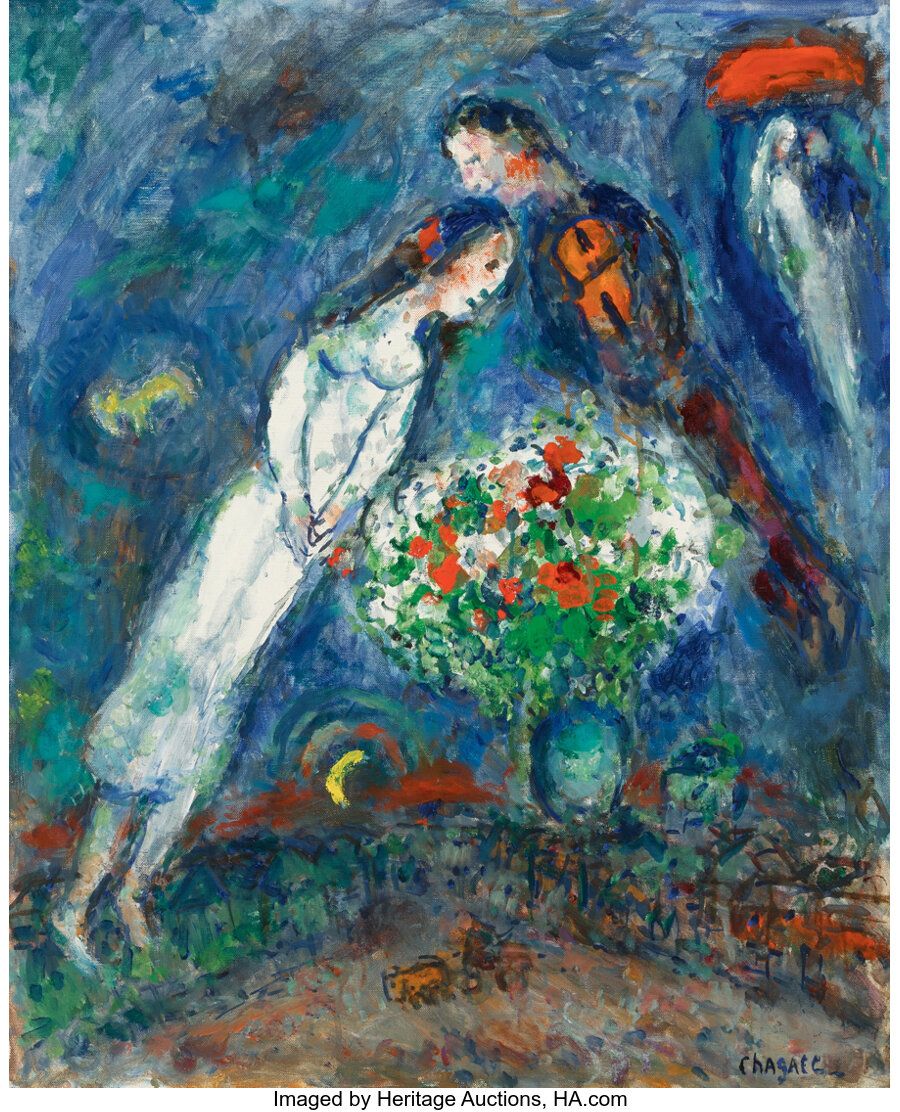Description
Marc Chagall (French/Russian, 1887-1985) Rencontre dans le ciel, circa 1980 Oil on canvas 29 x 24 inches (73.7 x 61....
Marc Chagall (French/Russian, 1887-1985) Rencontre dans le ciel, circa 1980 Oil on canvas 29 x 24 inches (73.7 x 61.0 cm) Signed lower right: Chagall Signed on the reverse: Marc Chagall Property from a Distinguished Collector and Philanthropist PROVENANCE: Estate of the artist; J.F. Gobbi Galerie d'Art, Neuchâtel, Switzerland; Acquired by the present owner from the above, 1996. The Comité Marc Chagall has confirmed the authenticity of this work. The lot is accompanied by a facsimile of a certificate of authenticity from the Comité Marc Chagall, no. 96430, dated April 18, 1996. The warmth of Marc Chagall's highly personal iconography and his strong modernist bent earned him status as one of the most beloved and popular artists of the twentieth century. Chagall journeyed from his native Belarus to Paris in 1910, befriending fellow artist André Lhote, through whom he absorbed all the inspiration that the Impressionists, Post-Impressionists, and Fauves had to offer, ultimately forming his own whimsical and emotional symbolic visual language which he used throughout his artistic career. The present work, tenderly executed in a deep, languid blue applied in a thick, brushy impasto, evokes a quiet moonlit meeting between two lovers, a motif that appears repeatedly throughout Chagall's oeuvre. While appearing to be an anonymous couple, the figure of the bride is representative of Chagall's first wife, his great love, Bella Rosenfeld, whom he met in 1909. Both the artist and Bella described experiencing love at first sight, something he recounted in his 2013 autobiography, My Life: "I feel she has known me always, my childhood, my present life, my future; as if she were watching over me, divining my innermost being...I knew, this is she, my wife..."(p. 77). From that moment on, Bella became Marc Chagall's eternal muse, and the couple became inseparable from their 1915 marriage until her untimely death in 1944. Bella was frequently shown, muse like, amid flowers in the open air. Chagall's 1917 work, Bella with White Collar, depicts his Venus larger than life, towering over a bright meadow – perhaps to scale with the size of his love for her. The feeling of unbridled love, boundless in scope, was not limited to Marc. In fact, it was visualized in both of their imaginations. Bella, herself a writer and poet, wrote of her feelings on their engagement, "I suddenly felt as if we were taking off. You too were poised on one leg, as if the little room could no longer contain you. You soar up to the ceiling. Your head turned down to me, and turned mine up to you... We flew over fields of flowers, shuttered houses, roofs, yards, churches." Bella's vision of soaring lovers being quiet literally swept off their feet by emotion was readily accepted by Chagall, who heavily featured floating couples in his work from the 1920s onward. After Bella died, art served as an outlet for Chagall's profound grief. In it he immortalized her. His portraits of her became nostalgic, and in the present work the vaporous figures appear as a sort of flashback; we see the couple centered in the composition, seemingly sharing confidences. And the same couple appears at the right edge of the work, standing huddled together under a red umbrella. It gives a similar effect to dreamy memory sequences in contemporary film, when two scenes are superimposed and shown at the same time. However instead of unravelling into tragedy or bitterness, Chagall imbues his work with a sweet longing, focusing on happy moments in years gone by, seemingly accepting the passage of love, life, and death, and bringing it forth poetically onto the canvas. To that end, Chagall packs his work with iconography. The moon, itself symbolic of immortality, casts a surreal, romantic light on these nocturnal rendezvous. Ever the romantic, florals feature heavily, the traditional calling card of any proper lover. Their ephemeral nature, arranged by human hands as they bloom before they eventually wilt, becomes everlasting in paint, suggesting that experiences of beauty and happiness, however short-lived, are always worth holding onto. Even their arrangement is significant. Chagall married his second wife, Valentina Brodsky, or "Vava", in 1950, and he found renewed happiness and respite from his grief over Bella through her. The expansive bouquets, perennially vibrant and overflowing, are representative of his feelings for the two great women in his life, their simple message being: there is love enough for all. Chagall's abundance of love prevents one from eclipsing another, though he loves Bella in his memories, he is able to love Vava in the present. In fact, while Bella appears so often in his work, living eternally in his paintings, it is because she is gone, not necessarily because she was more loved. Vava remains ph
69022
Marc Chagall (French/Russian, 1887-1985) Rencontre dans le ciel, circa 1980 Oil on canvas 29 x 24 inches (73.7 x 61....
